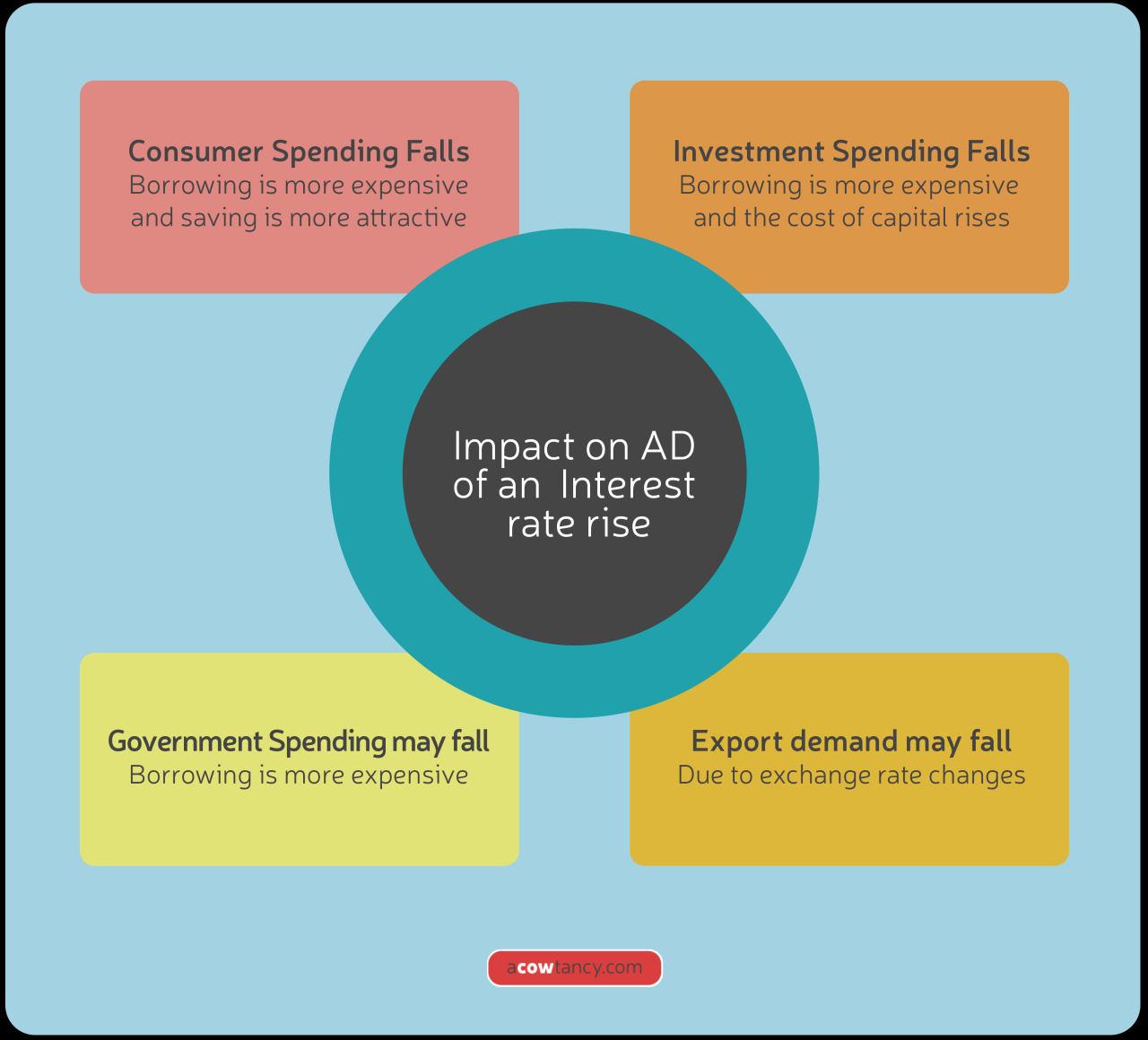
Beginning with Impact of Interest Rates on Investment Strategy, the narrative unfolds in a compelling and distinctive manner, drawing readers into a story that promises to be both engaging and uniquely memorable.
Exploring the intricate connection between interest rates and investment strategies sheds light on crucial decision-making processes in the financial realm.
Importance of Interest Rates in Investment

Interest rates play a crucial role in shaping investment decisions across various asset classes. Understanding how interest rates impact investments is essential for investors to develop effective strategies and maximize returns. Let’s delve into the relationship between interest rates and investment strategies, along with examples of how changes in interest rates can influence different investment options.
Impact on Bond Investments
When interest rates rise, bond prices tend to fall. This is because newly issued bonds offer higher yields, making existing bonds with lower yields less attractive. Conversely, when interest rates decline, bond prices tend to rise as older bonds with higher yields become more valuable.
Effect on Equity Investments
Rising interest rates can negatively impact equity investments, especially for companies with high levels of debt. Higher borrowing costs can lead to decreased profitability and lower stock prices. On the other hand, sectors like financials may benefit from higher interest rates as they can earn more on their investments.
Influence on Real Estate Investments
Interest rates also play a significant role in real estate investments. Higher interest rates can increase the cost of borrowing for real estate purchases, potentially slowing down property sales and price growth. Conversely, lower interest rates can stimulate demand for real estate, driving up property values.
Types of Investment Strategies

Investors utilize various investment strategies based on their financial goals and risk tolerance. Let’s delve into different types of investment strategies and how interest rates impact each one.
Growth Investment Strategy
A growth investment strategy focuses on investing in companies with high growth potential, such as technology or biotech firms. When interest rates are low, borrowing costs decrease, leading to increased spending and business growth. This environment is favorable for growth stocks as companies can borrow money at lower rates to fund expansion projects.
However, in a rising interest rate environment, borrowing becomes more expensive, which can hinder the growth prospects of companies. Investors may shift towards value or income strategies during these times.
Value Investment Strategy
Value investors look for undervalued stocks that have the potential to increase in price over time. When interest rates are low, these stocks become more attractive as borrowing costs are reduced, making it easier for companies to execute turnaround strategies and improve their financial performance.
Conversely, in a high interest rate environment, value stocks may struggle as borrowing costs rise, affecting the company’s ability to generate profits. Investors may seek alternative strategies to mitigate the impact of rising interest rates.
Income Investment Strategy
Income investors focus on generating a steady stream of income through dividends, interest payments, or rental income. In a low interest rate environment, income-generating assets like bonds or dividend-paying stocks become more appealing as investors search for higher yields.
However, when interest rates rise, the fixed income from these investments may become less attractive compared to other opportunities. Investors may need to reevaluate their portfolios to adapt to changing interest rate conditions.
Speculative Investment Strategy
Speculative investors are willing to take on higher risks in exchange for the potential of high returns. In a low interest rate environment, speculative investments like cryptocurrencies or high-growth stocks may see increased demand as investors chase higher returns.
However, when interest rates rise, the risk-return tradeoff becomes more pronounced, and speculative investments may experience heightened volatility. Investors need to carefully assess the impact of interest rates on their speculative holdings to manage risks effectively.
Impact of Interest Rates on Investment Vehicles
Interest rates play a crucial role in influencing the performance of various investment vehicles such as stocks, bonds, real estate, and other assets. Understanding how interest rates affect these investment options is essential for making informed decisions in your investment strategy.
Stocks
When interest rates are low, borrowing costs decrease, making it cheaper for companies to borrow money for expansion and growth. This can lead to increased spending, higher earnings, and ultimately a positive impact on stock prices. On the other hand, when interest rates rise, borrowing becomes more expensive, which can lower company profits and stock prices. Therefore, in a low-interest-rate environment, stocks tend to perform better compared to high-interest-rate periods.
Bonds
Bonds have an inverse relationship with interest rates. When interest rates rise, the value of existing bonds decreases as newer bonds offer higher yields. Conversely, when interest rates fall, the value of existing bonds increases as they offer higher yields compared to new issuances. Investing in bonds during a period of falling interest rates can result in capital gains as bond prices rise.
Real Estate
Real estate is also significantly impacted by interest rates. Lower interest rates make mortgages more affordable, leading to increased demand for housing and higher property prices. Conversely, rising interest rates can deter potential homebuyers due to higher borrowing costs, resulting in a slowdown in the real estate market. Investors looking to invest in real estate should consider the prevailing interest rates to make informed decisions.
Other Investment Vehicles
Apart from stocks, bonds, and real estate, other investment vehicles such as commodities, currencies, and alternative assets are also affected by changes in interest rates. Commodities like gold may perform well during times of economic uncertainty when interest rates are low, while currencies can experience volatility based on interest rate differentials between countries. Alternative assets like cryptocurrencies may also see fluctuations in value based on interest rate movements.
Recommendations on Selecting Investment Vehicles
Given the impact of interest rates on investment vehicles, it is crucial to consider the prevailing economic conditions when selecting investments. During low-interest-rate environments, stocks and real estate may offer better returns, while bonds can be attractive during periods of falling interest rates. Diversifying your investment portfolio across different asset classes can help mitigate risks associated with interest rate fluctuations and improve overall returns.
Role of Investment Advisors in Interest Rate Environment
Investment advisors play a crucial role in helping clients navigate the complexities of changing interest rate environments. They provide valuable guidance and insights to ensure that investment strategies are aligned with prevailing interest rate trends.
Responsibilities of Investment Advisors
- Assessing the impact of interest rate changes on different investment vehicles and portfolios.
- Developing tailored investment strategies based on interest rate forecasts and risk tolerance of clients.
- Monitoring market conditions and adjusting investment recommendations accordingly.
Communication between Investment Advisors and Clients
Investment advisors need to maintain open and transparent communication with their clients regarding the potential impacts of interest rate changes on their investment decisions. This includes discussing the rationale behind recommended strategies, addressing any concerns or questions, and providing regular updates on market developments.
Investment Horizon and Interest Rates
When it comes to investment strategy, the investment horizon plays a crucial role in determining how interest rates can impact the overall portfolio. The investment horizon refers to the length of time an investor intends to hold an investment before selling it. This can range from short-term investments, which are typically held for less than a year, to long-term investments, which are held for several years or even decades.
Short-Term vs. Long-Term Investments in Varying Interest Rate Environments
Short-term investments are more sensitive to changes in interest rates compared to long-term investments. In a rising interest rate environment, short-term investments like money market funds or short-term bonds may experience decreased returns as new investments can be made at higher rates. On the other hand, long-term investments such as stocks or long-term bonds may be less affected by short-term interest rate fluctuations, as they are held for a longer period.
- Short-term investment strategies may involve frequent buying and selling of securities to take advantage of interest rate changes.
- Long-term investment strategies focus on the underlying fundamentals of the investment rather than short-term market fluctuations.
Adjusting Investment Horizon to Mitigate Risks
Investors can adjust their investment horizon to mitigate risks associated with interest rate fluctuations. For example, in a rising interest rate environment, investors may consider shifting towards longer-term investments to lock in higher rates for a longer period. Conversely, in a falling interest rate environment, investors may opt for shorter-term investments to take advantage of rising rates in the future.
By adjusting the investment horizon, investors can tailor their portfolio to better withstand the impact of changing interest rates.
Investment Opportunities in Different Interest Rate Environments
Investors need to adapt their strategies based on the prevailing interest rate environment to maximize their returns and minimize risks.
Low-Interest Rate Environments
During periods of low-interest rates, investors often turn to sectors such as technology, consumer discretionary, and healthcare. These sectors tend to perform well as companies can borrow money at lower costs, leading to higher profitability and stock prices.
- Technology companies benefit from low-interest rates as they can fund research and development activities more affordably.
- Consumer discretionary sectors see increased consumer spending due to lower borrowing costs, boosting revenues for companies in this sector.
- Healthcare companies benefit from lower debt payments, allowing them to invest in innovation and growth.
High-Interest Rate Environments
Conversely, in high-interest rate environments, sectors like financials, utilities, and energy tend to perform better. These sectors are less reliant on borrowing and can benefit from higher interest rates.
- Financial companies benefit from higher interest rates by earning more on their loans and investments.
- Utilities tend to perform well as they have stable cash flows and can pass on higher borrowing costs to consumers.
- Energy companies can benefit from higher oil prices when interest rates are high, leading to increased revenues.
Diversification Strategies
To capitalize on investment opportunities across different interest rate environments, investors should consider diversifying their portfolios. By spreading investments across various sectors and asset classes, investors can reduce risk and take advantage of opportunities in both low and high-interest rate environments.
- Allocating investments across sectors that perform well in different interest rate environments can help balance out the impact of changing rates.
- Investing in fixed income securities with varying maturities can also help mitigate interest rate risk in a diversified portfolio.
- Real assets like real estate and commodities can provide a hedge against inflation and interest rate fluctuations, offering additional diversification benefits.
In conclusion, navigating the impact of interest rates on investment strategy requires a nuanced approach, balancing risks and opportunities to achieve optimal outcomes in varying economic landscapes.
FAQ Section
How do interest rates influence investment decisions?
Interest rates impact investment decisions by affecting borrowing costs, asset prices, and overall market conditions.
What are some examples of how changes in interest rates impact investment options?
Changes in interest rates can influence the attractiveness of stocks, bonds, real estate, and other investment vehicles based on their sensitivity to interest rate fluctuations.
How do investment advisors adapt strategies based on interest rate forecasts?
Investment advisors adjust strategies by considering anticipated interest rate movements and their potential impact on various investment options to optimize returns for clients.
What are some diversification strategies to capitalize on investment opportunities across different interest rate environments?
Diversification strategies involve spreading investments across different asset classes and sectors to minimize risk and maximize returns, especially in varying interest rate conditions.





